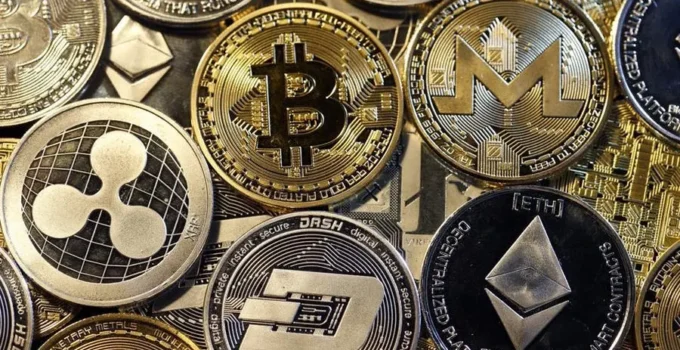Cryptocurrencies are decentralized digital currencies which the government does not control. The idea of cryptocurrencies dates back to the 1980s, when this concept appeared for the first time, although they were then called cyber currencies. They began to gain popularity in 2009, when the first digital currency, Bitcoin, was launched. The virtual coin was created by an anonymous individual or a group of programmers under the pseudonym of Satoshi Nakamoto.
Since the launch of Bitcoin, cryptocurrencies have gained more popularity, and many alternatives have appeared in the market. In the last few years, a great number of people have invested in digital assets and begun to buy Bitcoin with debit card, as cryptocurrencies have become a worldwide phenomenon. But what are cryptocurrencies, and where did they come from?
In this post, we will briefly examine the evolution and history of cryptocurrencies.
The first idea of cryptocurrencies – 1980s

Source: techxplore.com
Cryptocurrencies were mentioned for the first time in the 1980s when David Chaum, an American cryptographer, invented digital cash based on cryptography to verify and secure transactions. However, only in the early 1990s the cryptographic software and protocols began to be developed. They helped with the idea that creating decentralized digital coins could be possible.
In October 2008, a paper titled Bitcoin: A Peer-to-peer Electronic Cash System, signed by Satoshi Nakamoto, highlighted a system able to create a digital currency that didn’t need any third party. It was Nakamoto’s paper that helped with the launch of the cryptocurrency phenomenon.
The Creation of Bitcoin – 2009
Bitcoin is one of the most popular cryptocurrencies and a worldwide payment system. It was launched in 2009 and became increasingly popular for people who wanted to send money all across the globe without needing someone to interfere in this process, like the government or a bank. Still, because it had a high value, people began to be uncertain about what the future of Bitcoin would bring and what they could use this cryptocurrency for.
Nakamoto and Hal Finney made the first crypto transactions on 12th January 2009. But it wasn’t until the following year that people realized that Bitcoin was a valuable asset. For example, a person paid 10,000 Bitcoins to buy two Papa John’s pizzas. Today, that transaction would undoubtedly be worth millions of dollars.
The development of crypto market

Source: forkast.news
In 2010, Bitcoin was the only digital currency in the market. Also, at that time, its price was very cheap and cost just a few cents. But over the next few years, more digital coins appeared, and their prices rose and fell along with the one of Bitcoin.
In a period of volatility, people began to lose faith in crypto and doubt whether it was a safe investment vehicle or not. However, in late 2017, cryptocurrencies began to see unprecedented growth. For example, in January 2018, the total market cap for all the existing digital currencies reached $820 billion before crashing later in the same month. However, despite the crash, the crypto market has steadily grown.
The Era of Crypto Scam
2017 was the best year for cryptocurrencies. The value of Bitcoin and other digital currencies skyrocketed, but so did the number of scams and schemes that targeted crypto investors. Thieves stole millions of dollars from people who wanted to gain something in the crypto craze. Online hackers used many methods to succeed, making people fall for what they were offering, like phishing attacks or fake Initial Coin Offerings (ICOs).
These problems served as a cautionary tale, which is why the security improved over time, especially on the crypto exchanges. Now, crypto traders are advised to use a crypto wallet to store their digital assets safely rather than keeping them on an exchange. Wallets have become an important innovation to improve security and didn’t exist in the early days of cryptocurrency’s history.
The rise of Bitcoin’s popularity

Source: forkast.news
Over the years, Bitcoin has been the subject of many debates and discussions, but it is hard to know exactly the precise moment when the digital coin became so popular. Many think that the rise in popularity of Bitcoin happened in 2017 when it increased from $1,000 to $20,000 before falling back down below $10,000.
All cryptocurrencies are characterized by volatility, so the price constantly changes over the years, characterized by busts and recoveries. In late 2020, Bitcoin enjoyed a good time and a bull market with the help of the many big companies that bought this digital currency. In November 2021, Bitcoin reached the highest record of $69,000.
But since then, the crypto market has fallen again, dragged down by many concerns resulting from war, high inflation or rising interest rates. However, one thing is sure: Bitcoin is a popular digital coin that will grow as more people continue to become aware of its advantages, like anonymity and decentralization.
Final words
The crypto sector is increasing daily with innovations, and the market has become more stable because people have more knowledge on this subject. This is also happening with the introduction of new options, like decentralized finance (DeFi) or stablecoins. Because of so many alternatives people find currently, it is easy to get excited about cryptocurrencies and consider them as a potential investment.
Also, cryptocurrencies have become so popular because of blockchain, which can change and improve many sectors and industries. Blockchain technology has the potential to be used in any area of the economy, as it provides accessible financial exchange options and secure funds so that no one else will be able to access them.
Cryptocurrencies are a worldwide phenomenon that has brought many innovations and benefits for people. The crypto market is expected to grow in the next year as more digital currencies enter the stage. As digital transformations continue to change the world in which we live, cryptocurrencies will surely play an important role in the future of the money system.





